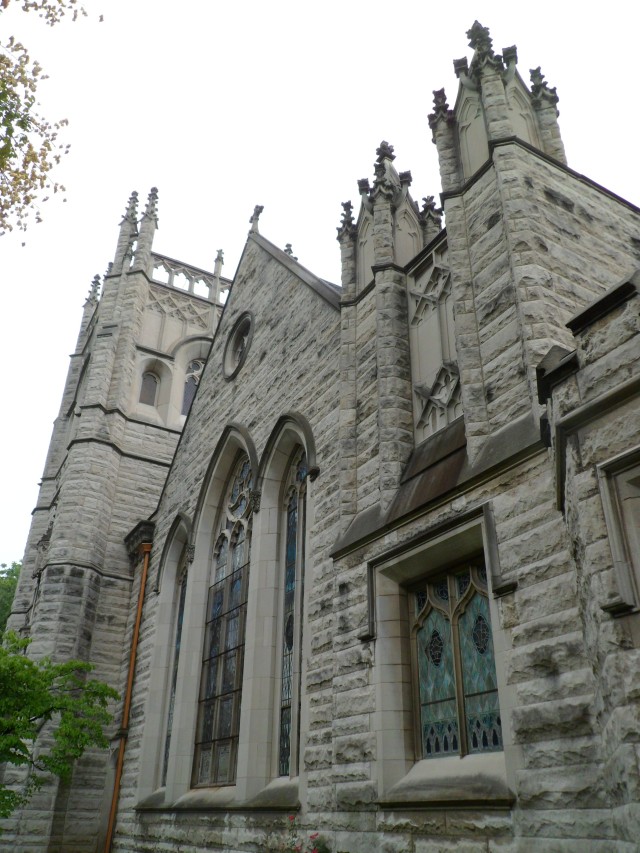[Please see also Madison Cawein’s Louisville II.]
My family recently traveled to Louisville, Kentucky in order to visit some of the important locations in Madison Cawein’s life and work. (See my other posts on Cawein here.) My photographs and commentary, along with some archival images (which are screenshots of pictures from Otto Rothert’s The Story of a Poet) for the purpose of comparison, can be found below.
This home, where Madison Cawein wrote over half of his books, is located at the southeast corner of Nineteenth and Market Streets. Madison lived here with his parents, Dr. William and Christina Cawein, from 1886 to 1903. It is no longer a private residence, as it is now the location of the Neurath-Schoppenhorst Funeral Home. The front porch is an addition / extension that was not present during Madison’s time.
Once Madison married Gertrude Foster McKelvey in June 1903, they moved into this home on the north side of Burnett Avenue, between First and Second Streets. In the present day, it seems that this building has been divided into three separate apartments.
From June 1907 to January 1914, Madison, Gertrude, their son Preston Hamilton, and Gertrude’s father and stepmother lived in this residence, which is located in the St. James Court neighborhood of Louisville. St. James Court and nearby Belgravia Court are two of the most beautiful, peaceful historic neighborhoods I’ve ever seen, with gorgeous Victorian homes, lush gardens and landscapes, tree-lined streets and sidewalks, and a lovely park and fountain in the center. Madison’s home, which is one of the prettiest on the street, features a historical plaque commemorating his life there. In his time, the interior boasted an extensive library, which is shown in the archival photo above. This home is still a private residence today.
Following a downturn in their financial fortunes, Madison and his family were forced to move across the street into this three-storey apartment building, where he lived until his death in December 1914. (When it was first constructed, the building had six storeys–which its neighbors on St. James Court were not pleased with–but it was reduced to three floors after a fire broke out in the upper levels.) It is still a condominium today.
This is the church where Madison and Gertrude were married; it is located next to St. James Court. During his time it was known as St. Paul’s Episcopal Church, but today it has become the West End Baptist Church.
This is the Louisville Free Public Library, which features beautiful architecture both inside and out. It contains a bust of Madison Cawein, sculpted by J.L. Roop, next to the second floor reference desk; the bust was presented to the library in April 1913. (Note what my mom likes to call the distinctive “Cawein nose” that Madison and I both seem to share.) The library’s collection of materials on Kentucky history includes two scrapbooks of newspaper clippings (from Louisville and elsewhere) on Madison Cawein’s life and work. I’ve read many of these articles before, as most of them are reprinted in Otto Rothert’s The Story of a Poet, but I found the act of paging through these scrapbooks to be a moving experience: the articles themselves are faded but still in fine condition, while the brittle pages to which they are taped were literally crumbling to pieces beneath my fingertips. I felt an overwhelming impression of how deeply Madison’s family, friends, and admirers loved both the man and his work–of how his finest poetry transcends time.
I also came across an interesting reference to a medallion portrait of Madison Cawein that was presented to the Louisville Free Public Library in February 1922. Alas, the medallion is no longer to be found in the library; it’s possible that it now resides somewhere in City Hall. I have inserted a scanned photocopy of the salient newspaper article here, as there is no mention of the medallion made in Rothert’s book.
This is the grave site of Madison, Gertrude, and William Cawein, which can be found in Louisville’s Cave Hill Cemetery. As can be seen in the photos above, Madison and Gertrude’s tombstones are surprisingly simple and modest.
And lastly, here’s a picture of me by the St. James Court fountain, with Madison Cawein’s third residence in the background. Just as Madison’s poetry expresses his abiding love for his Kentucky home, Louisville’s fascinating history shines through the beauty of its homes and landscapes.
























Your discovery of the Cawein and the Teasdale letters point out an important fact, that the totality of his extant correspondence is not included in Rothert’s book. I have a friend who has a number of letters related to or by Cawein that were apparently offered to Rothert and the Filson Society, but were not purchased or used. I am an art collector with a number of Eric Pape works in my collection; as you know Cawein and Pape were good friends. You may be familiar with the beautiful Eric Pape portrait of Gertrude Cawein in the wonderful Filson Museum in Louisville; I was surprised to find it behind a card catalog there when I was researching Cawein and Pape in their library. I made a donation and had my art restorer in Cincinnati restore the painting for the Filson, and they have promised to display it appropriately. I plan to visit in the spring of 2013 to see how it looks after restoration. I would certainly be interested in any information related to the Cawein and Pape families. Greg Conn, Madrid, Spain
Thank you for the information about the Eric Pape portrait of Gertrude Cawein! I’ve never visited the Filson Museum, so I was not aware that the painting was still extant. It’s great news to learn that you’ve rediscovered it, and it was extremely generous of you to make a donation to have it restored. I’ll have to try to visit Louisville again once it’s on display.
SCP